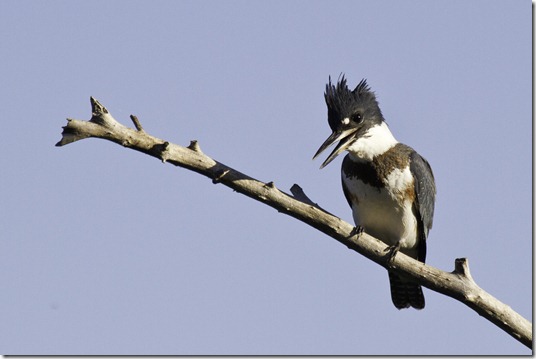Belted Kingfischer
Cool Facts
The breeding distribution of the Belted Kingfisher is limited in some areas by the availability of suitable nesting sites. Human activity, such as road building and digging gravel pits, has created banks where kingfishers can nest and allowed the expansion of the breeding range.
The Belted Kingfisher is one of the few bird species in which the female is more brightly colored than the male. Among the 93 species of kingfishers, the sexes often look alike. In some species the male is more colorful, and in others the female is.
During breeding season the Belted Kingfisher pair defends a territory against other kingfishers. A territory along a stream includes just the streambed and the vegetation along it, and averages 1 km (0.6 mi) long.The nest burrow is usually in a dirt bank near water. The tunnel slopes upward from the entrance, perhaps to keep water from entering the nest. Tunnel length ranges from 30 to 250 cm (1 to 8 ft).
Habitat
Lake/Pond
Breeds along streams, rivers, lakes, and estuaries with banks for nest holes.
Winters along coast, streams, and lakes.
Food
Fish
Fish. Also aquatic invertebrates, insects, and small vertebrates.
Nesting
Nesting Facts
Clutch Size
5–8 eggs
Egg Description
White.
Condition at Hatching
Helpless and naked.
Nest Description
Nest in burrow in bank near water. No lining used.
Nest Placement
Burrow
Behavior
Aerial Dive
Watches in clear water from perch or while hovering, plunges into water headfirst to catch prey in bill. Pounds prey on perch to kill it.
Conservation
status via IUCN
Least Concern
Populations may be decreasing in many areas.
Source: http://www.allaboutbirds.org/guide/Belted_Kingfisher/lifehistory

 (916) 434-2759
(916) 434-2759



